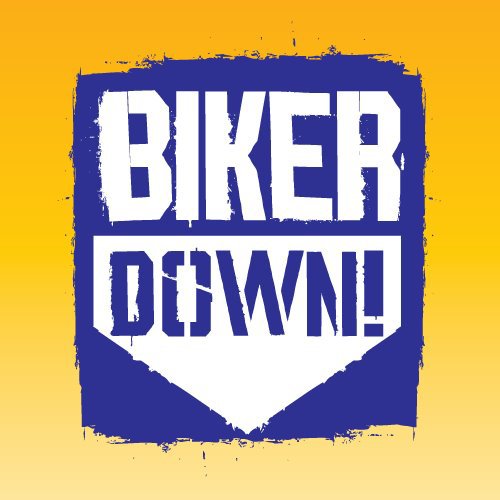
I was recently sent a screenshot from a video which included the expression “science of why we’re not seen on the road as motorcyclists”. It was shown on YouTube and featured an interview with Steve Reed of Biker Down North America at the Toronto Motorcycle Show earlier this month.

You’re probably aware if you’re a regular on my pages that I created a presentation called ‘Science Of Being Seen’ (SOBS) as a module of the award-winning ‘Biker Down’ course originally pioneered by Kent Fire and Rescue Service (KFRS).
As Biker Down was picked up nationwide, I made the background information my presentation was based on freely available to all fire services to use, requiring only a simple attribution to myself as the creator of the work. And I personally delivered the SOBS presentation until lockdown in 2020. Then in 2021, I was told that that SOBS was no longer going to be used and that it would be replaced by a brand-new ‘Thinking Biker’ video to be created in Canada. At the same time my personal connection with KFRS was to severed.
Since I was never officially connected with KFRS, the fact is I retain copyright on the Science Of Being Seen presentation and I continue to research the topic and deliver talks online and in person to motorcycle groups today.
So, as you might expect, I watched the video with interest to see the context in which that form of words was used.
Steve starts off by explaining how Biker Down came about:
“Biker Down was started over 10 years ago in the UK by UK Fire and Rescue and the premise was pretty simple… often times motorcyclists are riding together in groups or we’re riding the same great roads and so it’s sort of a natural thing that often times the first person upon a scene of a motorcycle accident could be a fellow rider. And so the the founder of Biker Down UK Jim Sanderson sort of had an epiphany moment when he was riding with a group and he came to decide that hey what we do actually isn’t that difficult we could teach it to the average rider and so that was sort of the genesis for Biker Down.”
Well, not quite.
This is going to be a very long post which I doubt that many people will be that interested in but I think it’s important to document exactly how the Biker Down course came into being, just what my connection with the course actually was, my involvement with Steve Reed and Thinking Biker, as well as how my time with Biker Down came to an abrupt end.
It true that it all started in 2011. It’s true that Jim Sanderson came up with the idea for Biker Down. Jim is a firefighter at Kent Fire and Rescue Service (KFRS) and he was out on a group ride when a rider came off on a fast dual carriageway. He had to go into professional mode to control the accident scene to protect the downed biker, and to organise emergency services to attend. He realised that he was the only one there that had much idea what to do. It’s also true that he realised that what he was doing wasn’t actually “that difficult” and that he could teach those crash management skills “to the average rider”.
So Jim set to and put together that accident scene management module. For the second module, covering emergency first aid, Jim enlisted the fire service’s in-house paramedics. Along with advice on emergency first aid, they also brought in the then-revolutionary idea that two people working together and using the correct technique could safely remove the helmet of an unconscious rider in order to clear the airway to assist with breathing, and also in the case that CPR was needed.
So far, so good.
But Jim also realised that to ‘sell’ the new safety intervention to the higher-ups at KFRS, a crash PREVENTION module would also be needed. And that’s where I got involved.
Jim and I had been knocking ideas back and forth across the internet for a couple of years by this point, discussing various safety issues such as the ‘Sorry Mate I Didn’t See You’ SMIDSY collision and group riding crashes. As he used to say later when introducing me at Biker Down events in Kent; “we didn’t always agree but when we didn’t and discussed it the bugger always seemed to be right”. Suffice to say, I changed Jim’s mind on several aspects of crashing!
So Jim messaged me about his planned course, and we had a back-and-forth discussion about what might work for this crash prevention module. I came up with several ideas.
With my suggestions in hand, Jim put the outline concept of Biker Down to his bosses and got permission to run three pilot courses on site at Ashford Fire Station, just so long as it was in his own time and run entirely by volunteers.
The first of the courses was delivered to members from the bike forum where we’d met. It was in the autumn, and as they were keen on group rides, I developed and delivered a talk on group riding techniques for them.
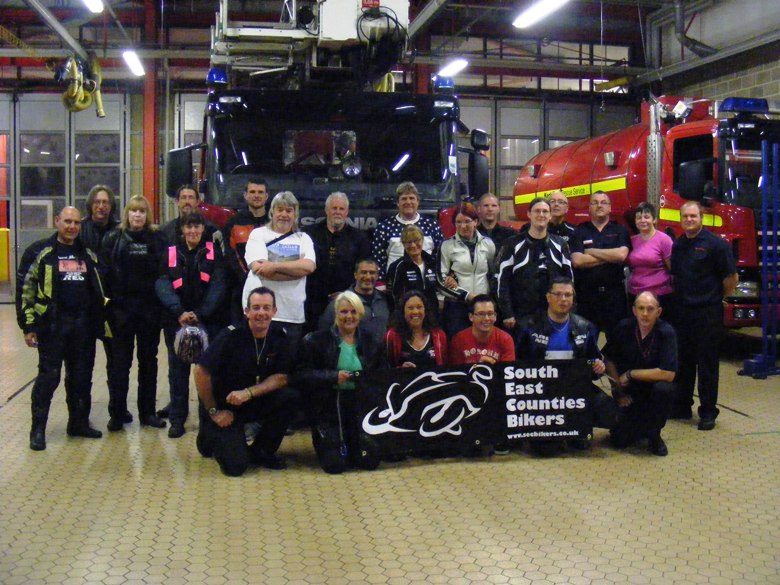 The very first Biker Down course
The very first Biker Down course
It included a demo of what often goes wrong on a group ride as the leader speeds up and everyone behind races to catch up. I used a piece of elastic, with cut-out cardboard bikes on it, stretched it out to represent the increase in speed, then let one end go – all the ‘bikes’ crashed into each other. I also got the attendees walking around the room to see how two different ‘marking systems’ worked – the ‘leapfrog’ (where a marker sits tight as everyone in the group goes past, until the backmarker arrives) and the ‘caterpillar’ system I learned on my training with the National Motorcycle Escort Group (where each rider waits only for the bike behind, whereupon they swap places).
Feedback was good enough to go ahead with the second pilot a few weeks later.
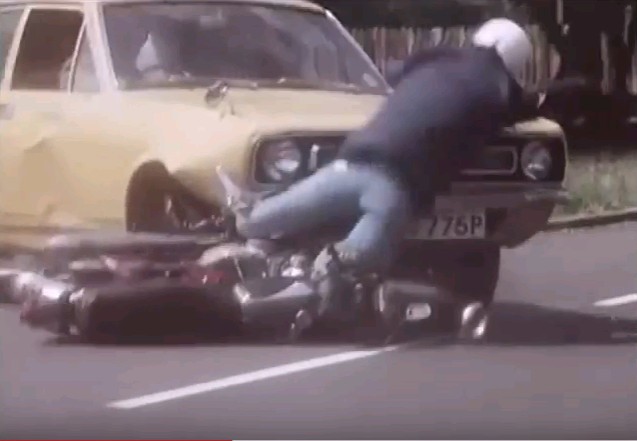 A still from the original ‘Think once, think twice, THINK BIKE’ public information film
A still from the original ‘Think once, think twice, THINK BIKE’ public information film
This time, I delivered a very different presentation – it was all about the reasons for collisions involving motorcycles and drivers at junctions (intersections). The key point was that rather than say “drivers don’t look properly”, I explained that almost all drivers DO look, but all too frequently, they fail to see the motorcycle. There’s a difference. I explained issues such as motion camouflage and looming, peripheral blindness and saccadic masking.
I also discussed the lack of practical evidence for any positive effect from day-riding lights and hi-vis clothing – there’s been no obvious reduction in the proportion of collisions happening at junctions. I pointed to research from the 70s that found that a dipped headlight made for a poor daytime light because the beam is focused below eye level of anyone looking at it, so a more diffuse light source was needed. And I also made the suggestion that it was likely that in daytime conditions in a rural environment, the best-contrasting colour for hi-vis was likely to be pink!
Jim was happier with this presentation and decided to adopt it for the third pilot, which ran a few weeks after the second. I gave it a few more tweaks, and when Biker Down was properly launched in the spring of 2012, it was this talk which was included.
It quickly became known as the ‘Science Of Being Seen’, and usually concluded the three-hour course. Jim got some funding from the road safety account too, for publicity, expenses for volunteers, and also to provide free first aid kits to attendees.
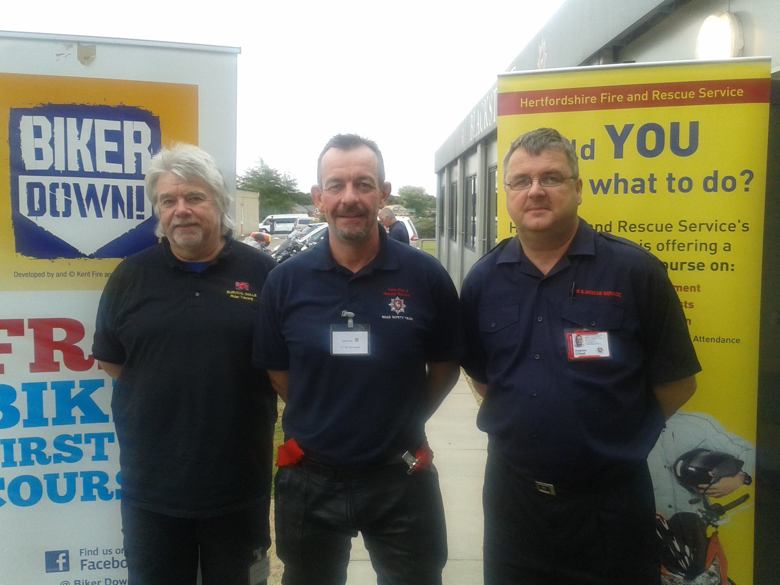 Kevin trainer and SOBS – Jim firefighter and crash scene management – Andy first responder and first aid
Kevin trainer and SOBS – Jim firefighter and crash scene management – Andy first responder and first aid
Jim had always wanted Biker Down to be ‘open access’ enabling any FRS in the UK to roll out the course, and by March, he’d created a Biker Down UK Facebook page to put the word out about what we were doing in Kent. I don’t know how many Biker Down courses we delivered at Ashford that year, but at one point, we were running one every couple of weeks and as well as the interest from bikers, it wasn’t long before other Fire and Rescue Services (FRSs) were sending representatives to see what it was all about.
Later in 2012, Biker Down was nominated for a Prince Michael of Kent International Road Safety Award. At the end of the year, we all made the trip to the Savoy in London for the awards ceremony, and we were very pleased to be one of the winners in the motorcycle category.
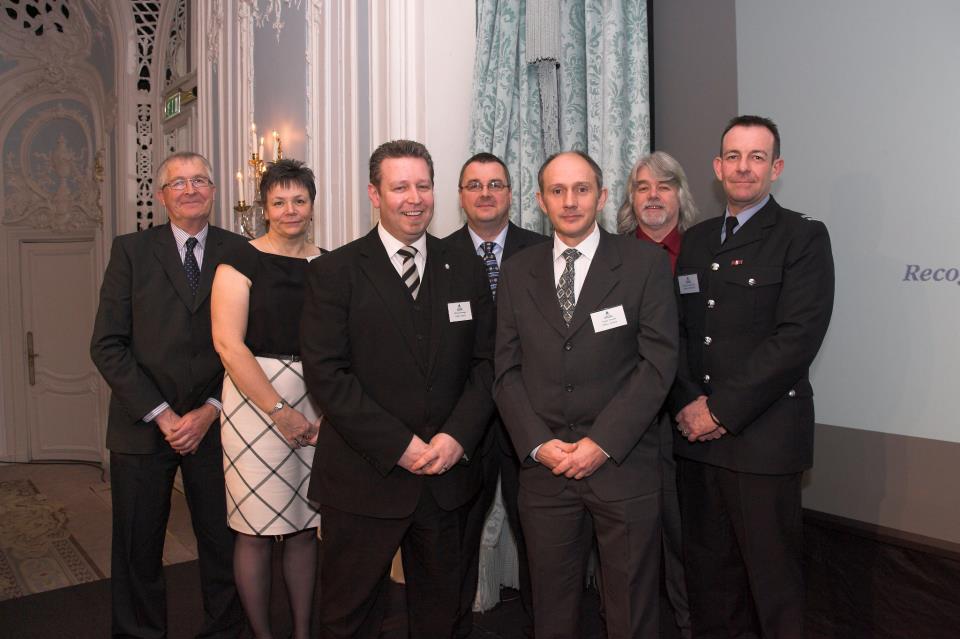 At the Savoy for the Prince Michael of Kent award ceremony
At the Savoy for the Prince Michael of Kent award ceremony
There was just one slight hitch – my status and connection with the fire service.
In-house fire service rules prohibit any activities that might seem to be promoting a commercial business. Since I run Survival Skills with an eye to eating and paying my bills, it might reasonably have been argued that even though I was giving my time for free, my relationship with KFRS was in violation of those rules.
Almost certainly because of that, there was a suggestion to bring me ‘on board’ by becoming an official volunteer, but I quickly realised that there was a big issue for me to consider. By becoming a volunteer my SOBS presentation would likely end up becoming the property of KFRS. I’d actually be handing over the rights to the talk. Not only could I potentially lose control over the content, but all I would be getting in return for my hundreds of hours of personal research would be expenses for attending and delivering the talk.
I mulled it over, and decided I needed to retain rights over my ‘intellectual property’ by not signing up as an official volunteer and thus continuing to provide the talk and my time for free. All my time was given gratis, free and for nothing. The only income I ever received was from selling books to attendees.
In the event, nothing more was said so I guess an official ‘blind eye’ was turned my way. Looking back, the only hint that there might have been an issue was that Jim created his OWN version of Science Of Being Seen for the ‘open access’ pack that he produced to be handed out to other FRSs. He said it was ‘dumbed down’ to allow any firefighter to deliver it. Retrospectively, it may have been a move to get around the intellectual property issue.
Over the next few years, I continued delivering SOBS at Biker Down events in Kent on a monthly basis.

We also ran courses at MCN’s offices up in Peterborough, and I went with the Thames Valley team to Honda’s Bracknell headquarters to deliver SOBS there.
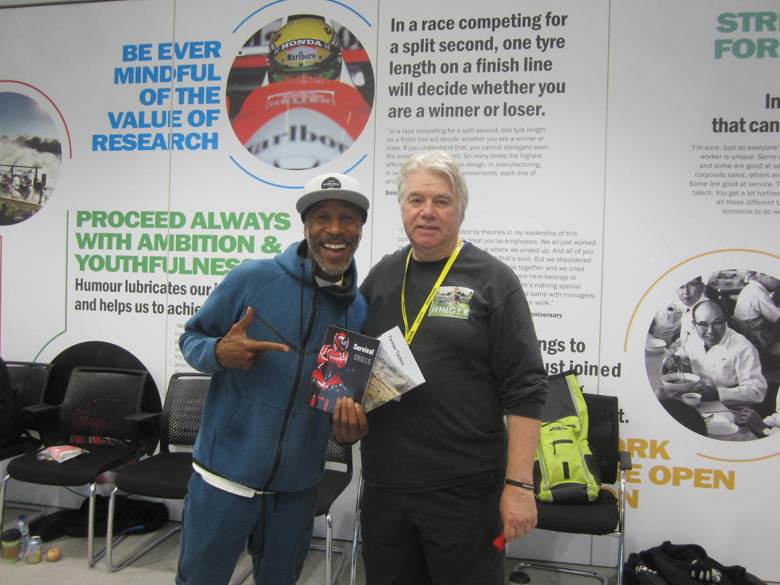 Yes, that is Danny John-Jules – he came along to the Honda Biker Down event
Yes, that is Danny John-Jules – he came along to the Honda Biker Down event
There were a couple of other events, details of which I can’t immediately recall. And in 2014, I was also invited to get involved in the KFRS ‘Ride Skills’ events at Brands Hatch too.
Back in 2012, the content of SOBS was far from universally accepted. Thanks to some searching questions – including a few hostile ones – I decided to create a more in-depth explanation of each element of the presentation with credits to the original research on which I had based each segment of SOBS.
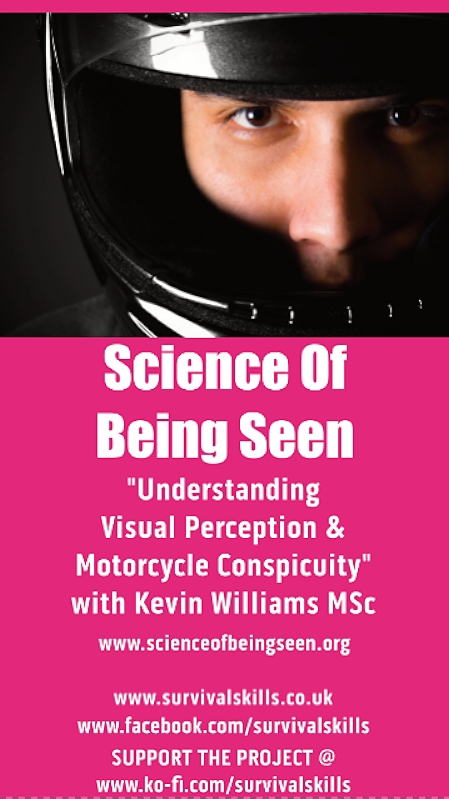 The banner with the Science Of Being Seen website
The banner with the Science Of Being Seen website
The obvious place to put this in-depth background information was online. It can be found at www.scienceofbeingseen.org and I included the link at the end of all my presentations, thus enabling anyone to access it and research the original sources themselves if they felt the need. I’m still updating the site regularly with newly-discovered research, by the way. I also summarised the presentation in a slim paperback to enable attendees to take away a ‘aide memoire’.
And that brings us to 2020. We had time for just one Biker Down event, right at the beginning of March 2020 before we went into lockdown.
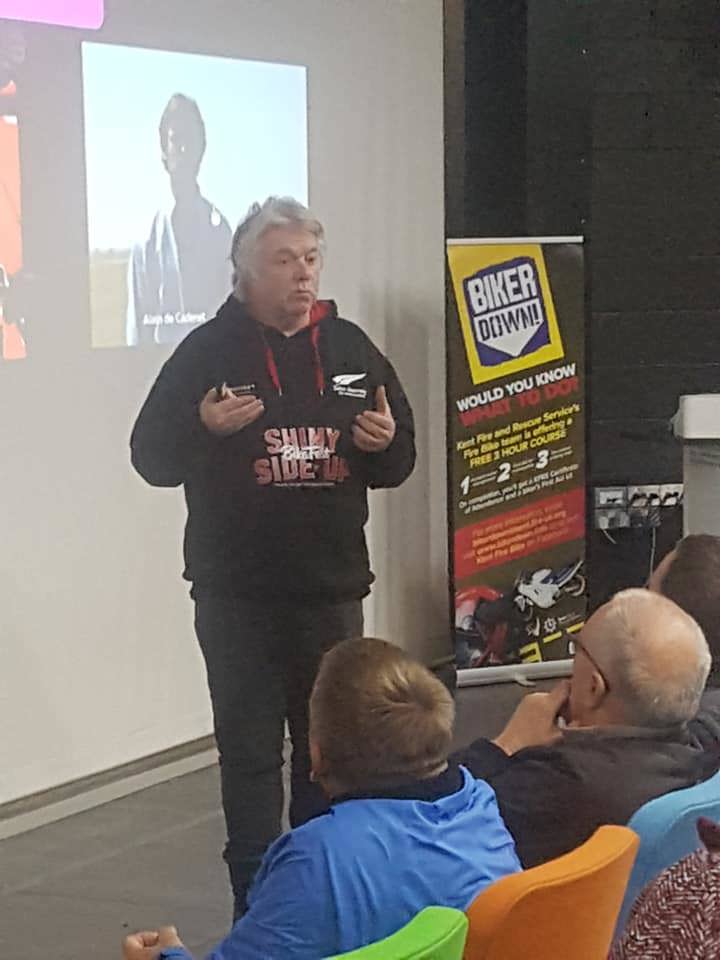 Kevin at the Rochester Road Safety Experience, March 2020
Kevin at the Rochester Road Safety Experience, March 2020
That was to be the last course I delivered for KFRS.
Now I need to backtrack to September 2018.
Jim announced that a Canadian company called Medical Data Carriers (MDC) was about to supply Biker Down with free sticky contact data cards to replace the ‘green dot’ cards that had been previously handed out with the first aid kit but were costing too much.

This is where the Steve Reed mentioned above comes into the story. It transpired that Steve was keen to set up Biker Down North America and in January 2021, Jim announced:
“Over the last 2 years I have been working closely with Steve Reed from MDC and we are now proud to hear that the National Fire Chiefs Council (NFCC) has approved Biker Down North America.”
At this point, internal discussions about how to relaunch Biker Down were underway, and I believe it was at Jim’s suggestion that I made contact with Steve in February and asked if he was familiar with SOBS. I sent him some background to explain why SOBS was part of Biker Down, and mentioned that SOBS had also been used by the New Zealand Transport Agency and their Accident Compensation Corporation on the Shiny Side Up rider safety interventions in 2018 and 2019. On February 20, Steve responded:
“I have been thinking about how best to deliver that 3rd module” and said ” I do see the value in your SOBS content and it would be very unique here in America.” He asked if the material and content could be “tuned easily for North America”.
I replied that I didn’t see any issue with that, as the same crash mechanisms apply, just in mirror image. We swapped a few more questions and answers, and Steve requested a video of me delivering the presentation and speaker notes. I duly provided those on March 10. On May 6, Steve asked for an ‘about you’ resume and photo, which I also sent over.

It was around six weeks later, on June 25, that I discovered my SOBS module was being replaced by a new ‘Thinking Biker’ video. This would be shown to promote a new discussion session as the final module of Biker Down, and it would be adopted right across the UK. I hadn’t heard a word about this previously, and at much the same time, I got a letter from the KFRS assistant manager for buildings and works to tell me that I was no longer allowed on fire service property. It appeared both SOBS and myself had been well and truly dumped without ceremony.
I’ll admit I’m speculating but I believe this is what probably happened. Whilst things were at a stand during lockdown, seeing that well over half of the county’s FRSs were running Biker Down courses at a local level, the National Fire Chiefs Council – the top body of the fire service – decided to adopt Biker Down as a national fire service initiative. At any event, Biker Down is now a module in the re-launched Enhanced Rider Course being offered by the DVSA. But whatever the facts, I won’t go into that any further.
It didn’t take long to discover that ‘Thinking Biker’ was being made in Canada, by Steve Reed. I sent Steve a message asking if he could: “update me on ‘The Thinking Biker’ and where – IF – SOBS fits in with this?”
Back came his reply.
“My IP lawyer found that we could not publicly use SOBS title for the module because someone had a trademark that had similarities in training here in North America. With that news and considering that there are several safety messages that we want to include in the module and that we may want to add more later, a more all encompassing name was selected that we could use. We are also making his [Jim’s] module in video to reduce staff costs. I am writing script now and it is going to be in the spirit of a Fort nine video. 8-10 minutes. So no we won’t be using your presentation for this.”
I ran Google searches on the ‘science of being seen’ term and drew a blank. As far as I can see, the only references are to SOBS as part of Biker Down, to my own website work, and as a presentation being delivered by myself. I’m guessing the issue was that the term ‘science of being seen’ was associated with myself and my Survival Skills training school.

Copyright – it’s on my SOBS work
Later that year, I attended a Biker Down course for myself in West London, hoping to see the Thinking Biker video. The presenter actually delivered a badly-mangled version of SOBS. When I mentioned I was the original author of SOBS and asked why we hadn’t been shown Thinking Biker, he told me it wasn’t quite ready for use.
Some months later, a contact at another FRS did send me a copy of Thinking Biker, so naturally I watched it. What was rather a surprise was to hear the presenter say at just 30 seconds into the video:
“Today, we’re taking a deep dive into the art and SCIENCE OF BEING SEEN on motorcycles.”
My capitals, by the way. So they couldn’t CALL the video ‘Science Of Being Seen’, but they could TALK about the science of being seen. Hmm.
=================================
WHAT IS SCIENCE OF BEING SEEN? (SOBS)SOBS is my in-depth investigation into the ‘Sorry Mate, I Didn’t See You (SMIDSY) collision between motorcycles and other vehicles.
Created for the fire services ‘Biker Down’ course, it’s based on science, not speculation.
I aim to quash some persistent myths about how and why junction collisions happen, and show how motorcyclists can employ simple techniques to stay out of trouble!
FIND OUT MORE – www.scienceofbeingseen.org
BUY THE SOBS e-book – https://ko-fi.com/s/88fbc15a82
WATCH OUT FOR LIVE ONLINE TALKS
BOOK ME FOR YOUR OWN EVENTS – info[at]survivalskills.co.uk
SUPPORT SOBS at www.ko-fi.com/survivalskills
=================================
So what does Thinking Biker cover? What are all the new safety messages that are included that weren’t in SOBS?
The first explanation is of foveal vision, an optical phenomenon I mention in SOBS.
Then comes the issue of saccadic masking during eye movements which shuts down the visual feed to prevent motion blur, plus the fixations which are the brief moments we actually gain visual data. That’s in SOBS. Moreover, Thinking Biker using the very same ‘vertical blinds’ metaphor I use in SOBS which I admit to having pinched myself from a very good video by the Association of British Drivers – they get a credit on the website and in the book. The only difference with the Thinking Biker explanation is that it uses a short video segment rather than a still picture. Oh, and the steering wheel’s on the other side of the car and traffic on the ‘wrong’ side of the road.
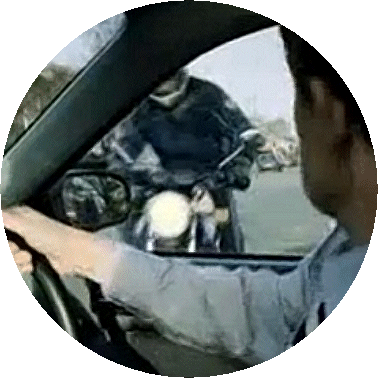
Next, we get a short clip of a driver looking but failing to see a motorcycle from one of the UK’s ‘Think Bike’ videos – I’ve used stills from the exact same video.
Following that is a very clever video of a horse galloping across a prairie amongst stationary grazing cows to flag up the effect of lateral motion on detection. This is a concept I was introduced to by Malcolm Palmer, another UK instructor at the time. Years back, Malc talked about a double ‘back and forth’ movement across the lane he called the ‘Z Line’ and proposed it would attract attention. I always credited Malc for that element of SOBS. But if an object is rapidly approaching against a static point background…” – as you probably guessed, it’s the concept of motion camouflage. I use a video clip of a Spitfire flying straight at the camera and being almost impossible to spot until it’s almost on top of the camera.
We’re then told that a driver devotes about 0.5 second to scanning an intersection; a figure that just happens to be in the SOBS presentation.
And then there’s a mention of visual obstructions caused by the windscreen pillars and blocked lines-of-sight because the motorcycle is behind another vehicle. Guess what? SOBS covers that too, using the ‘beam blindness’ term I picked up in a FortNine video.
What follows next is a rather confused segment where the presenter appears to recommend hi-vis in what they call ‘Neon green’ – we call it ‘Saturn yellow’. The argument is that this works because “humans are most sensitive to light at a wavelength of 555 nanometers”. That IS fresh info but having talked about the value of ‘Neon green’ as a hi-vis colour, the video actually shows a rider wearing a mixed yellow / orange sleeveless vest! It’s also very hard to see she is actually wearing hi-vis from the three-quarter ahead angle the video clip is filmed from – that’s the very reason I recommend hi-vis with sleeves, something that doesn’t get a mention.
Next item. “While Neon green may stand out against dull concrete jungles, it might blend in nicely in lush green environments.” Ah, right back to the SOBS script.
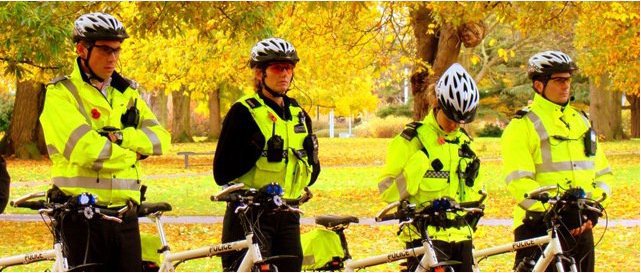 I’ve been using this wonderful photo to illustrate the relationship between foreground and background colours, and conspicuity.
I’ve been using this wonderful photo to illustrate the relationship between foreground and background colours, and conspicuity.
However, for some reason, the production team decided that using a photo of cannabis leaves was the right image for their ‘lush green environment’. Oh dear.
“As thinking bikers, we need to have multiple strategies at hand”. Our presenter is now shown holding an orange hi-vis in one hand, and a pink one in the other.
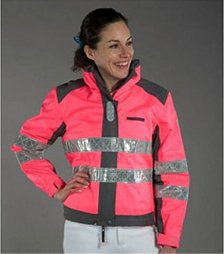 Pink with sleeves – as recommended by SOBS
Pink with sleeves – as recommended by SOBS
As far as I am aware, SOBS on Biker Down was first safety intervention to suggest that pink hi-vis is probably the most conspicuous in a rural environment – it’s less the sensitivity of the eye that matters, much more the contrast between the hi-vis and the background colours. As the humble colourwheel used for picking paint combos for home decorating shows, the colour that contrasts most strongly with yellow / green foliage is pink.
There’s one more element still to come – camouflage. And the example just happens to be the very same one that I use for SOBS – the tiger. Even though the tiger is hi-vis orange, the stripes disrupt the silhouette of the animal and help it to blend in with the environment. “If you use the right colour then use patterns to confuse the eye, you’re practically invisible”. Exactly as SOBS explains.
 The tiger graphic from my SOBS presentations
The tiger graphic from my SOBS presentations
Dazzle camouflage – also using an illustration that I’ve used myself – is also mentioned, but in a confusing segment that suggests that it means that “big blocks of contrasting colour make you stand out” rather than break up your outline. Unfortunately, once again, the presenter is wearing a sleeveless, two-colour vest. That’s very much the opposite of what SOBS suggests. Sticking to a single colour, even when it’s black, presents a coherent silhouette in a way that stripy, multi-colour vests don’t.
Struggling to see any new safety messages, I am reasonably certain that an impartial observer would also see that Thinking Biker covers much of the same ground as SOBS.
Since Thinking Biker largely parallels SOBS, I would say that it offers reasonably accurate information but there are some buts.
For starters, it’s not so logically ordered. I put a lot of thought into how to construct the talk so that ideas flow.
Second, Thinking Biker gets delivered in seven minutes. In such a short time there’s nothing like the depth of explanation I achieve with my presentations.
Third, there is that clear misunderstanding of the role of dazzle camouflage.
Fourth, there is the issue of discussing ‘Neon green’ whilst showing a very different dual-colour vest in the clip. SOBS talks about the role of a single colour – ANY colour – in creating the recognisable silhouette of bike and rider.
Fifth – and here my advice in SOBS diverges completely from Thinking Biker – there’s no mention of full sleeved hi-vis, only vests. It’s ironic that the video clip used to show the hi-vis vest in action amply illustrates my point – the dual-colour tabard is almost invisible from the chosen camera angle because most of it is obscured by the bike’s screen and the rider’s black leather sleeves. SOBS actively promotes the choice of a full-sleeved hi-vis jacket and emphasises the role of the rider’s arms in enhancing conspicuity.
Sixth – what’s missing? There’s nothing the issue of ‘saw, looked and misjudged speed and distance’. There’s nothing about day-riding lights or night-time conspicuity.
And seventh and pretty crucially in my opinion, there’s no mention of the need for a genuinely proactive approach to riding defensively. The biggest weakness of conspicuity aids is that they are entirely ‘passive protection’ and rely 100% on the driver of the other vehicle taking notice of the rider’s hi-vis and DRLs.
I use the final element of SOBS to emphasise the importance of taking proactive steps; changing position to ‘see and be seen’, applying the Australian technique of ‘setting up the brakes’ to reduce reaction times, the use of the horn as a warning when we think a driver might be about to move into our path, the surprising effect of reduce speed to cut stopping distances (halve speed, and stopping distance drops to one quarter), and the need to practice swerves and hard stops to keep them fresh.
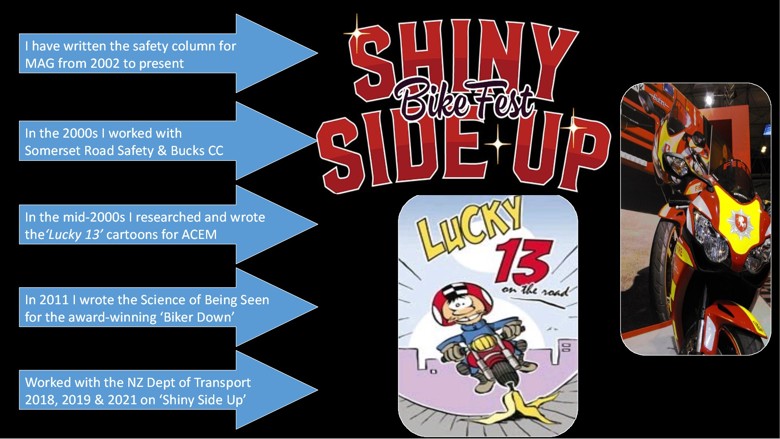 Taking SOBS online to New Zealand audiences for Shiny Side up in Feb 2021
Taking SOBS online to New Zealand audiences for Shiny Side up in Feb 2021
And then we roll to the end, and to the credits. We see: “Producer and writer – Steve Reed” then “Producer and writer – Jim Sanderson”.
Not a mention of my delivery of SOBS for the third module of Biker Down, no mention of me sending an annotated copy of the SOBS presentation plus background information to Steve, and no hint that the SOBS presentation might have been any kind of inspiration for the content of Thinking Biker.
Let’s return to the interview with Steve Reed at the Toronto Motorcycle show earlier this month. Steve says:
“Fast forward 10 years later, the UK has seen their motorcycle fatalities reduce by 30%. We like to attribute a lot of that to Biker Down and some other great programs there.”
A 30% reduction in motorcycle fatalities since Biker Down started? That’s a claim that I cannot see supported with any crash statistics I am aware of over the period from 2012 to 2022. Exclude the COVID year of 2020 when motorcycle and car use was down significantly on a normal year and crashes were down, the best you can say is that the figure has flat-lined.
And then he moves on to talk about the three modules. About the third module, Steve says that it is:
“…little bit of a proactive segment so in that we’re teaching a little bit of the science of why we’re not seen on the road as motorcyclists.”
Science of Why We’re Not Seen? Hmm.
He continues:
“So we’re talking about saccadic masking and looming and some other sciency stuff that really will make sense to us as motorcycle riders but also as car drivers to be better and more aware of our surroundings and especially motorcycle riders and some of the other things we touch upon in there is also conspicuity strategy so what should I be wearing in the urban environment what should I maybe be wearing when I’m outside of the urban environment and really helping people be prepared in that respect.”

I’ve seen comments to the effect that I don’t ‘own’ the science. That’s true, and I have never claimed to. One of the reasons for producing the SOBS website was to ensure that the authors of the original research WERE credited, something I never have time to do during the live presentation.
Nor did I perform the original research. I certainly didn’t discover motion camouflage or the phenomenon of looming, I don’t claim any discovery of saccadic masking, nor was I the first to suggest dazzle camouflage – though I did manage to describe it correctly.
What I believe was unique about SOBS back in 2012 was that for the very first time all the disparate elements behind the ‘Sorry Mate I Didn’t See You’ SMIDSY crash were brought together:
- SOBS brought in the three mechanisms that cause collisions at junctions; looked and COULD NOT see, looked but FAILED to see, looked, saw but MISJUDGED speed and distance.
- SOBS looked at how the structure of the vehicle and roadside obstacles obscured views for drivers and made motorcycles difficult to see.
- SOBS introduced riders to the science of visual perception in order to explain just how and why drivers can look but fail to see motorcycles at intersections or misjudge their speed and distance.
- SOBS looked at the science behind conspicuity aids to explain their strengths and weaknesses, and why riders should not assume that their use will ensure they are seen.
- SOBS made a big point of emphasising the crucial role to be played by a genuinely proactive approach to identifying the threat, assessing the risk and proactively managing those risks.
By pulling these threads together, SOBS was able to tell a coherent story about the SMIDSY to motorcyclists for the first time.
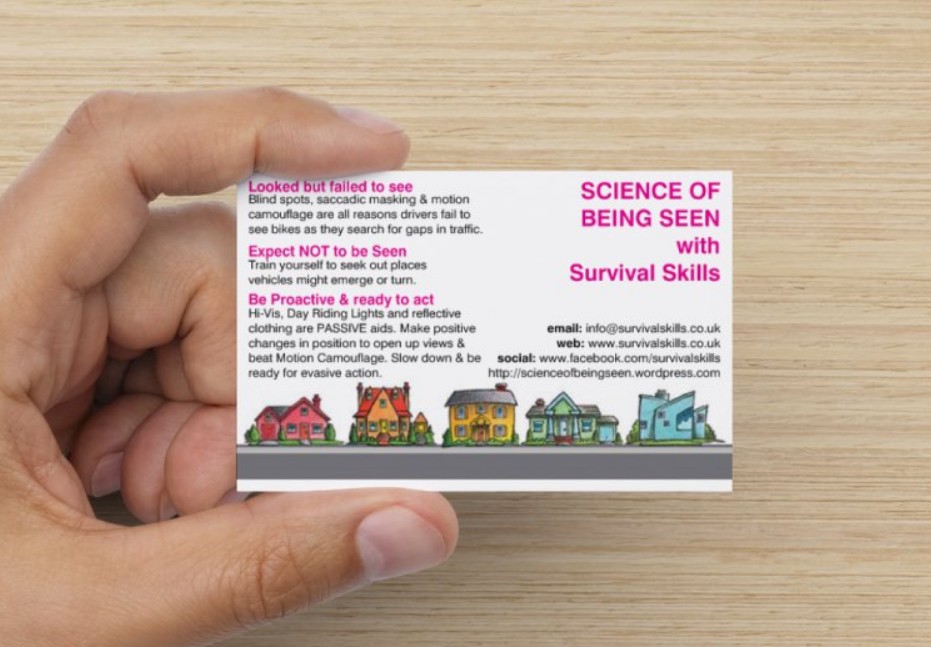 The business card with the essentials of SOBS given to Biker Down attendees by me
The business card with the essentials of SOBS given to Biker Down attendees by me
It IS possible that Steve Reed employed people to perform a literature survey of the research into the SMIDSY collision, which duly came up with more or less the exact-same conclusions I had previous reached. After all, the background science is unchanged.
So I leave you to draw your own conclusions about Thinking Biker and where the source material most likely came from.
I mentioned intellectual copyright. Had the idea for the Science Of Being Seen come from inside KFRS, and had I developed SOBS under their instruction, then I think it almost certain that my contributions to Biker Down would been legitimately regarded as the property of KFRS. In that case, KFRS could have passed that information on to Steve Reed.
But the facts are these; I was asked to develop a suitable module for Biker Down and went on to create SOBS from scratch. As I’ve also pointed out, SOBS was the second presentation created. I’d argue this means I was in the role of an outside ‘consultant’ being brought in to develop and deliver a suitable course, and since the choice of content was left to me, I would argue the concept and content of SOBS remains my intellectual property.
Having said that, the intent was always to share the fruits of my research freely to ALL motorcyclists to help improve understanding of the SMIDSY crash, just as I have done for years via my posts on forums and on Facebook. For that reason, the SOBS website and all the content in it is provided under a Creative Commons Licence. The sole requirement is that anyone using my research in their own work attributes it to me.
I neither asked for, nor took, a penny from KFRS or any of the FRSs for developing the presentation or for my time spent delivering it. Nor did I ask for payment from Biker Down North America when recording and annotating the video for them. I placed one and only one condition on using the content of SOBS, whether by the UK FRSs or by Biker Down North America – if my information was used, I asked to be credited with the original idea for the presentation.

That’s all I requested, and I know that many of the UK FRSs delivering SOBS as part of Biker Down have scrupulously referenced my contribution at the end of their own presentations. The credit requested is conspicuous by its absence.
This isn’t ‘sour grapes’. I will always be thankful to Jim for that initial invite to become involved, even if the parting of the ways in 2021 could have been handled with more sensitivity. I’m very proud of what Biker Down has achieved, both in terms of the awards and developing from a local rider safety initiative to something that’s been recognised as of national significance. And I’m still happy to support Biker Down whenever I can – I will still talk up the course and I have stickers in the car and on the bike.
But I am left with a degree of frustration about what has happened subsequently, after after I sent Steve Reed the SOBS video, transcript and speaker notes in good faith, and how my input appears to being written out of the official story.
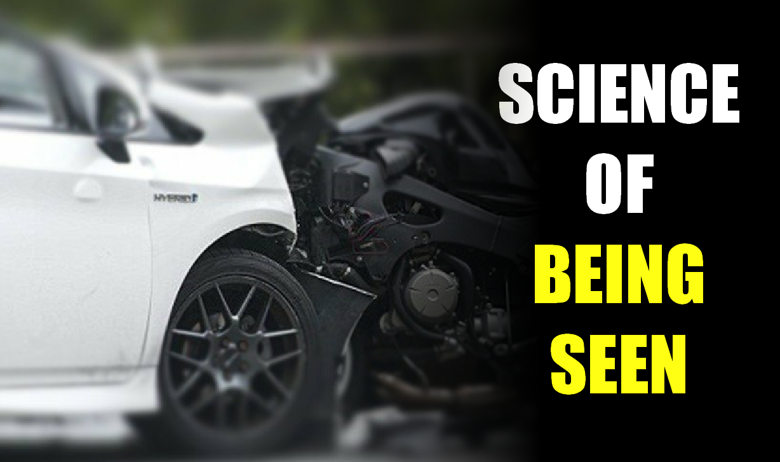 The most recent SOBS graphic
The most recent SOBS graphic
Anyway, done is done, and I will leave it at that, having explained my perspective. Thanks for reading, and I hope you know have a better understanding of the relationship between myself, KFRS and Biker Down, and the new ‘Thinking Biker’ video.
================================
PLEASE SUPPORT ‘SCIENCE OF BEING SEEN’
The ‘Science Of Being Seen’ project (SOBS) is FUNDED ENTIRELY BY MYSELF and I need YOUR SUPPORT to continue my research.
The SOBS project is FREELY AVAILABLE to all motorcyclists and aims to help improve our understanding of the ‘Sorry Mate, I Didn’t See You’ SMIDSY collision.
You can find the full project at:
https://scienceofbeingseen.org/
PRESENTATIONS ALWAYS AVAILABLE
IN PERSON OR ONLINE
Help out with research, writing and hosting!
Donate just £3 at https://ko-fi.com/U7U0KE0S
because every little helps!
================================